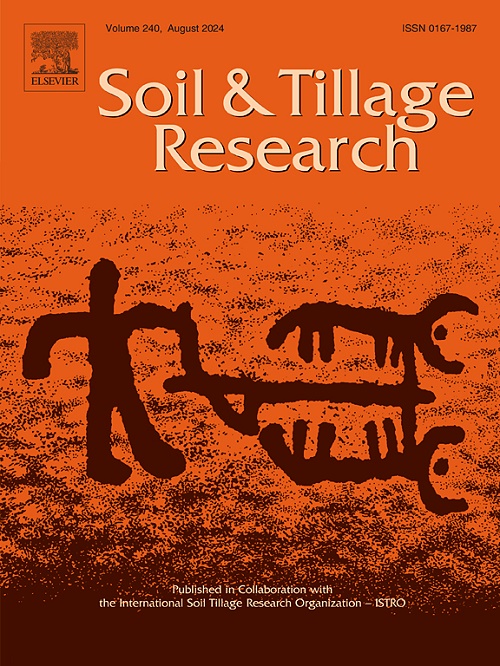Spatial prediction and dynamic change of soil organic carbon using remote sensing variables as auxiliary information in wavy plain, Northeast China
IF 6.1
1区 农林科学
Q1 SOIL SCIENCE
引用次数: 0
Abstract
Remote sensing (RS) data, which provide rich spatial information, can effectively reflect soil physical and chemical properties. These data can complement environmental variables for soil organic carbon (SOC) prediction, reducing the influence of covariance between topographic variables in wavy landscapes areas and improving prediction accuracy. This study focuses on improving prediction accuracy and applying SOC content prediction models in wavy plains. We constructed three RS variables, normalized difference vegetation index (NDVI), land surface temperature (LST) and temperature vegetation drought index (TVDI), based on Landsat satellite images, and combined them with climate, topography, and soil property variables. We then used random forest (RF), residual regression kriging (RRK), and ordinary regression kriging (ORK) models to predict SOC content. The spatial distribution of SOC content in a typical wavy plain area of Northeast China was mapped for the first time at a resolution of 30 m, using data from 2708 soil sampling points and 18 environmental variables. The results indicated that: ① The best prediction model in this study area was the RF model (R2 = 0.68, RMSE = 2.96, MAE = 2.38) with RS data as supporting information. ② Over the past three decades, SOC content had shown an upward trend, although its spatial distribution consistently displayed higher values in the east and lower values in the west. The area with rising SOC content was twice as large as the area with falling SOC content, accounting for 63.5 % of the total area. ③ Climate and elevation were the main factors influencing the spatial distribution of SOC content. In this study, new environmental variables based on RS inversion algorithms were introduced, compensating for the loss of prediction accuracy of topographic variables in spatial modeling. The spatial prediction accuracies of the RF, RRK, and ORK models were improved by 12 %, 30 %, and 3 %, respectively. This study can serve as a reference for high-precision SOC mapping in similar areas and assist relevant authorities in managing ecosystems and improving SOC content in these regions.
基于遥感辅助信息的东北波浪形平原土壤有机碳空间预测及动态变化
遥感数据能够有效地反映土壤的理化性质,提供丰富的空间信息。这些数据可以补充环境变量对土壤有机碳(SOC)预测的影响,减少地形变量间协方差的影响,提高预测精度。本研究的重点是提高预测精度和在波浪形平原上应用有机碳含量预测模型。基于Landsat卫星影像,构建归一化植被指数(NDVI)、地表温度(LST)和温度植被干旱指数(TVDI)三个遥感变量,并将其与气候、地形和土壤性质变量相结合。然后,我们使用随机森林(RF)、残差回归克里格(RRK)和普通回归克里格(ORK)模型来预测有机碳含量。利用2708个土壤采样点和18个环境变量,首次在30 m分辨率下绘制了东北典型波状平原区土壤有机碳含量的空间分布图。结果表明:①以RS数据为支持信息的RF模型(R2 = 0.68, RMSE = 2.96, MAE = 2.38)是研究区的最佳预测模型。②近30 a来,土壤有机碳含量总体呈上升趋势,但空间分布总体上呈现东高西低的趋势。土壤有机碳含量上升的面积是土壤有机碳含量下降面积的2倍,占总面积的63.5 %。③气候和海拔是影响土壤有机碳含量空间分布的主要因素。本研究引入了基于RS反演算法的新环境变量,弥补了空间建模中地形变量预测精度的损失。RF、RRK和ORK模型的空间预测精度分别提高了12 %、30 %和3 %。该研究可为类似地区土壤有机碳高精度制图提供参考,并为相关部门管理生态系统和提高土壤有机碳含量提供参考。
本文章由计算机程序翻译,如有差异,请以英文原文为准。
求助全文
约1分钟内获得全文
求助全文
来源期刊

Soil & Tillage Research
农林科学-土壤科学
CiteScore
13.00
自引率
6.20%
发文量
266
审稿时长
5 months
期刊介绍:
Soil & Tillage Research examines the physical, chemical and biological changes in the soil caused by tillage and field traffic. Manuscripts will be considered on aspects of soil science, physics, technology, mechanization and applied engineering for a sustainable balance among productivity, environmental quality and profitability. The following are examples of suitable topics within the scope of the journal of Soil and Tillage Research:
The agricultural and biosystems engineering associated with tillage (including no-tillage, reduced-tillage and direct drilling), irrigation and drainage, crops and crop rotations, fertilization, rehabilitation of mine spoils and processes used to modify soils. Soil change effects on establishment and yield of crops, growth of plants and roots, structure and erosion of soil, cycling of carbon and nutrients, greenhouse gas emissions, leaching, runoff and other processes that affect environmental quality. Characterization or modeling of tillage and field traffic responses, soil, climate, or topographic effects, soil deformation processes, tillage tools, traction devices, energy requirements, economics, surface and subsurface water quality effects, tillage effects on weed, pest and disease control, and their interactions.
 求助内容:
求助内容: 应助结果提醒方式:
应助结果提醒方式:


